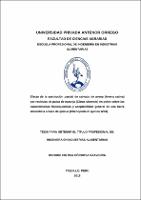| dc.contributor.advisor | Pretell Vásquez, Carla | |
| dc.contributor.author | Córdova Saavedra, Brooke Cinthia | |
| dc.creator | Córdova Saavedra, Brooke Cinthia | |
| dc.date.accessioned | 2018-03-06T14:48:04Z | |
| dc.date.available | 2018-03-06T14:48:04Z | |
| dc.date.issued | 2017 | |
| dc.identifier | T_ALIM_334 | |
| dc.identifier.other | T046_43021960T | |
| dc.identifier.uri | https://hdl.handle.net/20.500.12759/3778 | |
| dc.description.abstract | Se evaluó el efecto de la sustitución parcial de salvado de avena (Avena
sativa) por residuos de pulpa de naranja (Citrus sinensis) en polvo (26.66,
53.33 y 80%) sobre el contenido de fibra cruda, firmeza y aceptabilidad
general de una barra alimenticia a base de quinua (Chenopodium quinoa
Wild). Las variables respuesta fueron evaluadas dentro de las 48 h
después de elaborada la barra alimenticia. El análisis estadístico se
realizó con un nivel de confianza del 95%. La prueba de Levene demostró
la homogeneidad de varianza en las variables paramétricas. El análisis de
varianza indicó el efecto significativo (p<0.05) de la sustitución de salvado
de avena por residuos de pulpa de naranja en polvo sobre el contenido de
fibra cruda y firmeza. En la prueba de Duncan se determinó que la
sustitución de salvado de avena por residuos de pulpa de naranja en
polvo al 80% permitió obtener el mayor contenido de fibra cruda 10.86%,
mientras que para la firmeza instrumental la sustitución de 80% calificó
como el mejor valor con 9.86 N; por ser el valor más cercano a los
obtenidos en las barras comerciales. En la aceptabilidad general, el
tratamiento de sustitución de salvado de avena por residuos de naranja
en polvo al 53.33% obtuvo el mayor promedio (7 puntos) correspondiente
a la percepción ‘’Me gusta bastante’’. La prueba de Friedman evidenció
diferencia significativa (p<0.05) entre las muestras evaluadas. La prueba
de Wilcoxon, confirmó que la barra con sustitución al 53.33% tuvo la
mayor aceptabilidad general siendo la mejor en características
sensoriales. La sustitución de salvado de avena por residuos de pulpa de
naranja en polvo al 53.33% es considerada el mejor tratamiento por
presentar alto contenido de fibra cruda, adecuada firmeza instrumental y
la mayor aceptabilidad general en barras alimenticias a base de quinua. | es_PE |
| dc.description.abstract | Was evaluated the effect of the partial replacement of oat bran (Avena
sativa) by powdered orange (Citrus sinensis) pulp residues (26.66, 53.33
and 80%) on raw fiber content, firmness and general acceptability of a
quinua (Chenopodium quinoa Wild) based food bar. The response
variables were evaluated within 48 h after the food bar was elaborated.
The statistical analysis was performed with a confidence level of 95%.
Levene test demonstrated the homogeneity of variance in the parametric
variables. The analysis of variance indicated the significant effect (p<0.05)
of the substitution of oat bran by residues of powdered orange pulp on the
crude fiber content and firmness. The Duncan test determined that the
substitution of oat bran by 80% orange pulp residues allowed to obtain the
highest content of crude fiber 10.86%, while for the instrumental firmness
the substitution of 80% qualified as the better value with 9.86 N; for being
the value closest to those obtained in the commercial bars. In the general
acceptability, the oat bran substitution by orange powder residues
treatment at 53.33% produced the highest average (7 points)
corresponding to the perception ““I like it a lot““. The Friedman test showed
a significant difference (p<0.05) between the samples evaluated. The
Wilcoxon test confirmed that the bar with 53.33% substitution had the
highest general acceptability being the best in sensory characteristics. The
oat bran substitution by orange pulp powder residues at 53.33% is
considered the best treatment due to its high crude fiber content, adequate
instrumental firmness and the greater general acceptability in quinoa
based food bars. | en_US |
| dc.description.uri | Tesis | es_PE |
| dc.format | application/pdf | es_PE |
| dc.language.iso | spa | es_PE |
| dc.publisher | Universidad Privada Antenor Orrego | es_PE |
| dc.relation.ispartofseries | T_ALIM_334 | |
| dc.rights | info:eu-repo/semantics/openAccess | es_PE |
| dc.rights.uri | https://creativecommons.org/licenses/by/4.0/ | es_PE |
| dc.source | Universidad Privada Antenor Orrego | es_PE |
| dc.source | Repositorio Institucional - UPAO | es_PE |
| dc.subject | Pulpa de Naranja | es_PE |
| dc.subject | Salvado de Avena | es_PE |
| dc.title | Efecto de la sustitución parcial de salvado de avena (avena sativa) por residuos de pulpa de naranja (citrus sinensis) en polvo sobre las características fisicoquímicas y aceptabilidad general de una barra alimenticia a base de quinua (chenopodium quinoa wild) | es_PE |
| dc.type | info:eu-repo/semantics/bachelorThesis | es_PE |
| thesis.degree.level | Licenciatura | es_PE |
| thesis.degree.grantor | Universidad Privada Antenor Orrego. Facultad de Ciencias Agrarias | es_PE |
| thesis.degree.name | Ingeniero en Industrias Alimentarias | es_PE |
| thesis.degree.discipline | Ingeniería en Industrias Alimentarias | es_PE |
| dc.publisher.country | PE | es_PE |


